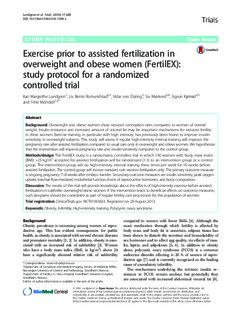| dc.contributor.author | Lundgren, Kari Margrethe | |
| dc.contributor.author | Romundstad, Liv Bente | |
| dc.contributor.author | Düring, Vidar Von | |
| dc.contributor.author | Mørkved, Siv | |
| dc.contributor.author | Kjøtrød, Sigrun Beate | |
| dc.contributor.author | Moholdt, Trine Tegdan | |
| dc.date.accessioned | 2020-03-06T12:51:50Z | |
| dc.date.available | 2020-03-06T12:51:50Z | |
| dc.date.created | 2016-06-08T11:42:36Z | |
| dc.date.issued | 2016 | |
| dc.identifier.issn | 1745-6215 | |
| dc.identifier.uri | http://hdl.handle.net/11250/2645826 | |
| dc.description.abstract | Background
Overweight and obese women show reduced conception rates compared to women of normal weight. Insulin resistance and increased amount of visceral fat may be important mechanisms for reduced fertility in these women. Exercise training, in particular with high intensity, has previously been found to improve insulin sensitivity in overweight subjects. This study will assess if regular high-intensity interval training will improve the pregnancy rate after assisted fertilization compared to usual care only in overweight and obese women. We hypothesize that the intervention will improve pregnancy rate and insulin sensitivity compared to the control group.
Methods/design
The FertilEX study is a randomized, controlled trial in which 140 women with body mass index (BMI) >25 kg/m2 accepted for assisted fertilization will be randomized (1:1) to an intervention group or a control group. The intervention group will do high-intensity interval training three times per week for 10 weeks before assisted fertilization. The control group will receive standard care assisted fertilization only. The primary outcome measure is ongoing pregnancy 7–8 weeks after embryo transfer. Secondary outcome measures are insulin sensitivity, peak oxygen uptake, brachial flow-mediated endothelial function, levels of reproductive hormones, and body composition.
Discussion
The results of this trial will provide knowledge about the effects of high-intensity exercise before assisted fertilization in subfertile overweight/obese women. If the intervention leads to beneficial effects on outcome measures, such programs should be considered as part of regular fertility care procedures for this population of women. | nb_NO |
| dc.language.iso | eng | nb_NO |
| dc.publisher | BMC | nb_NO |
| dc.rights | Navngivelse 4.0 Internasjonal | * |
| dc.rights.uri | http://creativecommons.org/licenses/by/4.0/deed.no | * |
| dc.title | Exercise prior to assisted fertilization in overweight and obese women (FertilEx): study protocol for a randomized controlled trial | nb_NO |
| dc.type | Journal article | nb_NO |
| dc.type | Peer reviewed | nb_NO |
| dc.description.version | publishedVersion | nb_NO |
| dc.source.volume | 17:268 | nb_NO |
| dc.source.journal | Trials | nb_NO |
| dc.identifier.doi | 10.1186/s13063-016-1398-x | |
| dc.identifier.cristin | 1360246 | |
| dc.description.localcode | © 2016 Lundgren et al.Open AccessThis article is distributed under the terms of the Creative Commons Attribution 4.0International License (http://creativecommons.org/licenses/by/4.0/), which permits unrestricted use, distribution, andreproduction in any medium, provided you give appropriate credit to the original author(s) and the source, provide a link tothe Creative Commons license, and indicate if changes were made. The Creative Commons Public Domain Dedication waiver(http://creativecommons.org/publicdomain/zero/1.0/) applies to the data made available in this article, unless otherwise stated. | nb_NO |
| cristin.unitcode | 194,65,25,0 | |
| cristin.unitcode | 1920,13,0,0 | |
| cristin.unitcode | 194,65,20,0 | |
| cristin.unitcode | 1920,7,0,0 | |
| cristin.unitcode | 194,65,15,0 | |
| cristin.unitname | Institutt for sirkulasjon og bildediagnostikk | |
| cristin.unitname | Kvinneklinikken | |
| cristin.unitname | Institutt for samfunnsmedisin og sykepleie | |
| cristin.unitname | Klinikk for kliniske servicefunksjoner | |
| cristin.unitname | Institutt for klinisk og molekylær medisin | |
| cristin.ispublished | true | |
| cristin.fulltext | original | |
| cristin.qualitycode | 1 | |

